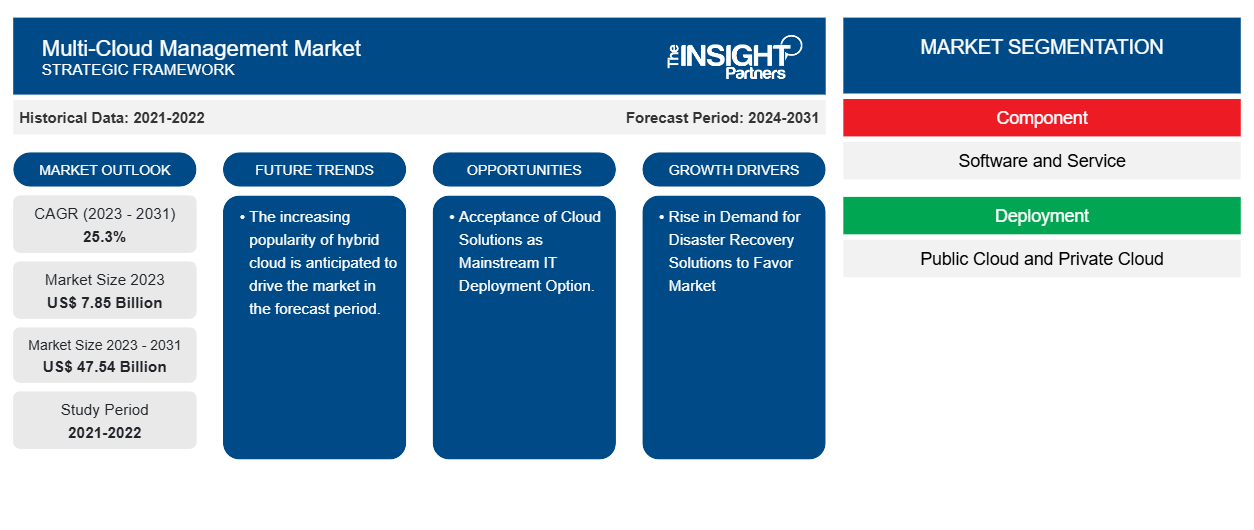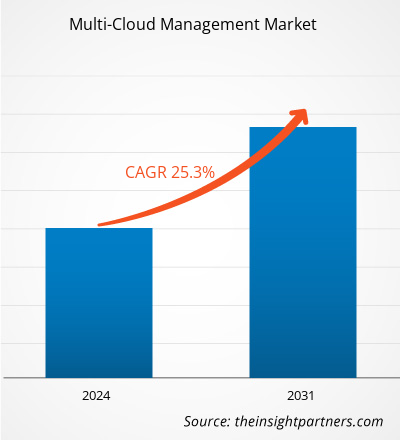The multi-cloud management market size is projected to reach US$ 47.54 billion by 2031 from US$ 7.85 billion in 2023. The market is expected to register a CAGR of 25.3% during 2023–2031. The surge in need to avoid vendor lock-in. Vendor lock-in refers to a situation where an organization chooses to transfer its business from its current vendors but cannot do so because of several reasons, such as projected cost, duration, and complexity of switching and the rise in demand for disaster recovery solutions are likely to be the key trends and drivers for the multi-cloud management market.
Multi-Cloud Management Market Analysis
The multi-cloud management market is experiencing significant growth globally. This growth is attributed to the surge in the need to avoid vendor lock-in and the rise in demand for disaster recovery solutions. Moreover, the growing popularity of the hybrid cloud, increase in data generation and rise in bring your device (BYOD) and choose your device (CYOD) are anticipated to drive the market in the coming years.
Multi-Cloud Management Market Overview
Multi-cloud management is considered a set of tools and procedures that enables a business to secure and monitor applications and workloads across multiple public clouds. A multi-cloud management solution enables IT teams to manage multiple clouds from a single interface and supports multiple cloud platforms such as Azure and AWS.
Customize This Report To Suit Your Requirement
You will get customization on any report - free of charge - including parts of this report, or country-level analysis, Excel Data pack, as well as avail great offers and discounts for start-ups & universities
Multi-Cloud Management Market: Strategic Insights

-
Get Top Key Market Trends of this report.This FREE sample will include data analysis, ranging from market trends to estimates and forecasts.
Multi-Cloud Management Market Drivers and Opportunities
Rise in Demand for Disaster Recovery Solutions to Favor Market
Disaster Recovery (DR) is a crucial aspect of any cloud deployment. According to statistics from World Backup Day, 10% of computers are attacked by viruses each month, and 30% of people never back up their data. Furthermore, mishaps, including staff members erasing data that was not backed up elsewhere, account for 29% of disasters. Moreover, various companies in the market are engaged in offering disaster recovery solutions. For example, the Persistent Multi-Cloud Disaster Recovery solution enables enterprises to accomplish application mobility and data protection without any limitations to achieve business resistance. IT managers can securely and quickly protect every application, operating system, container, database, data, etc., in a hybrid and multi-cloud infrastructure.
Acceptance of Cloud Solutions as Mainstream IT Deployment Option.
The majority of businesses globally accept cloud services as a feasible IT deployment model. The highest popular rationale for cloud adoption continues to be the flexibility and data security of the cloud as a delivery platform. Many businesses have migrated to one or more cloud services, influencing others to uptake the cloud to gain a competitive advantage. Cloud is currently recognized as a credible deployment model within the context of an organization’s IT strategy, with satisfaction levels remaining high and the global two-thirds of end users using a cloud service today expecting to expand their footprint over the coming year.
Multi-Cloud Management Market Report Segmentation Analysis
Key segments that contributed to the derivation of the multi-cloud management market analysis are component, deployment, application, and verticals.
- Based on component, the multi-cloud management market is divided into software and service. The software segment is anticipated to hold a significant market share in the forecast period.
- Based on deployment, the multi-cloud management market is divided into public cloud and private cloud. The public cloud segment is anticipated to hold a significant market share in the forecast period.
- By application, the market is segmented into infrastructure and resource management, identity and policy management, compliance management, metering and billing, and provisioning and lifecycle management. The infrastructure and resource management segment is anticipated to hold a significant market share in the forecast period.
- By Verticals, the market is segmented into IT and telecom, BFSI, government, retail and consumer goods, travel and hospitality, healthcare and life science, and others. The IT and telecom segment is anticipated to hold a significant market share in the forecast period.
Multi-Cloud Management Market Share Analysis by Geography
The geographic scope of the multi-cloud management market report is mainly divided into five regions: North America, Asia Pacific, Europe, Middle East & Africa, and South & Central America.
North America has dominated the multi-cloud management market. The increase in the multi-cloud management market in North America is majorly attributed to a drastic increase in data, the rising adoption of IoT and cloud infrastructure, and a surge in data center construction. Cloud computing is a major trend across all organizations in North America. The cloud is fast becoming the new norm for enterprises in the US and Canada. Moreover, a strong emphasis on research and development in the developed economies of the US and Canada is forcing the North American players to bring technologically advanced solutions into the market. In addition, the US has a large number of multi-cloud management market players who have been increasingly focusing on developing innovative solutions. All these factors contribute to the region's growth of the multi-cloud management market.
Multi-Cloud Management Market Regional Insights
The regional trends and factors influencing the Multi-Cloud Management Market throughout the forecast period have been thoroughly explained by the analysts at The Insight Partners. This section also discusses Multi-Cloud Management Market segments and geography across North America, Europe, Asia Pacific, Middle East and Africa, and South and Central America.
Multi-Cloud Management Market Report Scope
| Report Attribute | Details |
|---|---|
| Market size in 2023 | US$ 7.85 Billion |
| Market Size by 2031 | US$ 47.54 Billion |
| Global CAGR (2023 - 2031) | 25.3% |
| Historical Data | 2021-2022 |
| Forecast period | 2024-2031 |
| Segments Covered |
By Component
|
| Regions and Countries Covered |
North America
|
| Market leaders and key company profiles |
|
Multi-Cloud Management Market Players Density: Understanding Its Impact on Business Dynamics
The Multi-Cloud Management Market is growing rapidly, driven by increasing end-user demand due to factors such as evolving consumer preferences, technological advancements, and greater awareness of the product's benefits. As demand rises, businesses are expanding their offerings, innovating to meet consumer needs, and capitalizing on emerging trends, which further fuels market growth.

- Get the Multi-Cloud Management Market top key players overview
Multi-Cloud Management Market News and Recent Developments
The multi-cloud management market is evaluated by gathering qualitative and quantitative data post primary and secondary research, which includes important corporate publications, association data, and databases. A few of the developments in the multi-cloud management market are listed below:
- Oracle and Google Cloud announced a partnership that gives customers the choice to combine Oracle Cloud Infrastructure (OCI) and Google Cloud technologies to help accelerate their application migrations and modernization. (Source: Oracle, Company Website, June 2024)
- Verizon Business has announced Network as a Service (NaaS) Cloud Management, a new service that enables businesses to control application components and network architecture across multiple cloud environments – public, private and hybrid, in a unified online portal. (Source: Verizon, Company Website, February 2024)
Multi-Cloud Management Market Report Coverage and Deliverables
The “Multi-Cloud Management Market Size and Forecast (2021–2031)” report provides a detailed analysis of the market covering below areas:
- Multi-cloud management market size and forecast at global, regional, and country levels for all the key market segments covered under the scope.
- Multi-cloud management market trends as well as market dynamics such as drivers, restraints, and key opportunities.
- Detailed PEST/Porter’s Five Forces and SWOT analysis.
- Multi-cloud management market analysis covering key market trends, global and regional framework, major players, regulations, and recent market developments.
- Industry landscape and competition analysis covering market concentration, heat map analysis, prominent players, and recent developments for the Multi-cloud management market.
- Detailed company profiles.
Frequently Asked Questions
What is the expected CAGR of the multi-cloud management market?
What would be the estimated value of the multi-cloud management market by 2031?
What are the future trends of the multi-cloud management market?
Which are the leading players operating in the multi-cloud management market?
What are the driving factors impacting the multi-cloud management market?
Which region dominated the multi-cloud management market in 2023?
- Historical Analysis (2 Years), Base Year, Forecast (7 Years) with CAGR
- PEST and SWOT Analysis
- Market Size Value / Volume - Global, Regional, Country
- Industry and Competitive Landscape
- Excel Dataset
Recent Reports
Related Reports
Testimonials
Reason to Buy
- Informed Decision-Making
- Understanding Market Dynamics
- Competitive Analysis
- Identifying Emerging Markets
- Customer Insights
- Market Forecasts
- Risk Mitigation
- Boosting Operational Efficiency
- Strategic Planning
- Investment Justification
- Tracking Industry Innovations
- Aligning with Regulatory Trends





















 Get Free Sample For
Get Free Sample For